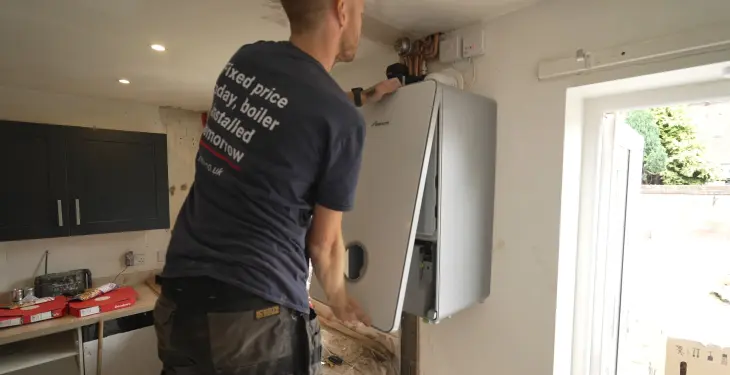

Written by Stephen Day
Gas Safe Engineer
Updated: 12th August, 2025
Understanding why a Vaillant boiler fails to provide hot water entails recognising the signs of trouble, pinpointing the root causes, and applying the appropriate fixes.
Get a new boiler quote, save up to £550 per year (0% APR available).
Experiencing no hot water can significantly disrupt daily life, making even simple tasks like washing dishes or taking a shower a challenge. For homes equipped with a Vaillant boiler, understanding the common causes of this issue in 2025 is essential for a swift resolution.
Insufficient hot water or complete absence thereof typically hails from various sources ranging from pressure imbalances and circulation issues to component failures or system blockages.
Homeowners with Vaillant boilers might encounter these problems due to wear, improper system settings, or a lack of routine maintenance.
As each scenario requires a different approach based on whether the issue is mechanical or systemic, a step-by-step diagnosis is crucial. Correctly pinpointing the cause not only saves time but also can prevent the cost and inconvenience of unnecessary repairs.
Combating these challenges calls for a blend of DIY troubleshooting, routine check-ups, and, at times, professional heating engineer assistance.
Get a quote in 60 seconds, fitted as fast as next day!
0% APR finance available.
Understanding why a Vaillant boiler fails to provide hot water entails recognising the signs of trouble, pinpointing the root causes, and applying the appropriate fixes. Vaillant boilers are known for their reliability, yet at times they may encounter issues affecting hot water supply.
When a Vaillant boiler is failing to produce hot water, homeowners usually notice the absence of hot water despite the heating functioning correctly. The boiler's display may also show fault codes such as F22, indicating low water pressure, or F75, which points to a pump water shortage or pressostat issue.
Vaillant boilers could fail to supply hot water for various reasons:
Low Water Pressure: An error code, often F22, flags this issue. It impedes adequate water flow and heating.
Faulty Components: Fault codes, such as F27, signal an issue with the flame detection. Parts such as thermistors, pumps, or diverter valves may also fail.
Electrical Faults: If the boiler is non-responsive to the thermostat or displays no power, the problem might be electrical. A common fix involves checking the fuse box.
Seasonal Issues: During winter, system pipes might freeze, causing blockages and malfunctions.
Resolving Vaillant boiler hot water issues includes several steps:
Check Pressure:
Restore pressure if below 1 bar. The re-pressurising procedure is often detailed in the manufacturer's manual.
Reset Error Codes:
For issues such as F75, a system reset might clear the fault.
Component Replacement:
Replace faulty thermistors, pumps, or diverter valves if specific error codes or symptoms suggest a malfunction.
Electrical Troubleshooting:
Reset the boiler or check the main fuse box for power supply issues.
Seasonal Maintenance:
Prevent winter-related issues by insulating pipes. If already frozen, cautiously thaw the pipes.
When tackling issues with Vaillant boilers, it's fundamental to grasp their operation and the integral components within the central heating system. These insights enable a methodical approach to diagnosing and rectifying no hot water situations.
A Vaillant combi boiler operates as a high-efficiency water heater and a central heating unit without the need for a separate hot water tank. Water is heated directly from the mains when a tap is turned on, delivering hot water on demand. At the heart of this process lies the plate heat exchanger, which facilitates the transfer of heat from the burner to the water. The pump propels the heated water to the radiators and the taps, regulated by the thermostat to ensure consistent room temperatures and water heat levels. The printed circuit board (PCB) serves as the system's controller, overseeing operations like ignition and monitoring through sensors for pressure and temperature.
Additionally, a key component, the diverter valve, plays a pivotal role in directing the flow of water either to the radiators or the hot water outlets. It assesses where hot water is required—in the heating system or at the taps—and adjusts accordingly.
The central heating system comprises several elements working in unison to provide warmth:
Boiler: The core unit producing hot water and heat for the home.
Radiators: These distribute heat emanating from the hot water coursing through them.
Pump: It propels the hot water from the boiler to the radiators.
Gas valve, ignition leads, and flame sensor: These parts manage the fuel entry and ignition process in the boiler, ensuring a consistent flame for heating the water.
Temperature and pressure sensors: These monitor the system's health, providing inputs to the PCB to make necessary adjustments.
Thermostat: This device allows users to set the desired temperature, signalling the boiler to activate or deactivate to maintain that setpoint.
A well-maintained boiler and heating system should operate smoothly, but when problems with no hot water arise, these components should be checked for functionality as they are critical to the system's effectiveness.
Vaillant boilers rely on correct water pressure and flow to operate efficiently. Inadequate pressure or poor circulation can lead to hot water shortages, necessitating a thorough diagnosis.
To ensure your Vaillant boiler functions properly, check the pressure gauge regularly. Ideal boiler pressure typically ranges between 1 to 1.5 bars when the system is cold. If the pressure is too low, below 1 bar, it's considered to have low boiler pressure. This can manifest as a lack of hot water or heating, often correctable via the filling loop to re-pressurise the system.
A boiler suffering from low water pressure might indicate a leak within the system. Inspect pipes and radiators for signs of moisture that could point to leaks. Even small leaks can affect the pressure, so it is vital to address them promptly. Should the pressure too frequently drop, there might be a more significant issue at hand.
The flow of water within your heating system is integral to its effectiveness. Low water flow rate can result in hot water not reaching the taps, or in cases where there is hot water but no heating. To assess the system's water pressure, one should review whether all valves are open and if any blockages are inhibiting the flow through the pipes. Systematic checks of the condition of the pipes, ensuring they are not constricted or corroded, may unearth issues affecting the circulation.
If the water flow rate appears diminished, it could be due to a faulty pump or a blockage in the system. In some instances, cleaning the pipes or replacing a section can restore proper circulation, while at other times, a professional may be required to repair or replace compromised components.
When addressing hot water issues with Vaillant boilers, it is essential to scrutinise the fuel and ignition systems thoroughly. Ensuring a consistent gas supply and the proper functioning of the ignition components can often rectify common heating faults.
A primary requirement for a boiler's operation is a reliable gas supply. Without it, the system cannot produce heat.
Steps for checking the gas supply:
Verify the gas valve: Ensure the main gas valve is in the 'on' position.
Examine other gas appliances: If other appliances are also not working, there may be a problem with the overall supply. In this case, contacting the gas company is advised.
If the supply is intact but the boiler still fails to heat water, the issue may lie within the internal components – such as the gas valve within the boiler not opening correctly – which requires professional assistance.
The pilot light and ignition are integral for boiler start-up:
Pilot light: Check if the pilot light is on. A persistent pilot light issue might indicate a faulty thermocouple or an incorrect flame detection, which halts the supply of gas as a safety measure.
Ignition: Modern boilers have electronic ignition units. If the electrical supply is steady but the boiler hasn't ignited, the issue could be due to a failed ignition. Look for error codes that can help diagnose the problem, and consider resetting the boiler. If the issue persists, it will necessitate a call to a certified engineer to replace or repair the ignition unit.
Conducting these checks can often lead to a quick resolution. However, when these measures do not yield results, professional intervention is required to ensure safety
In the context of a Vaillant boiler not delivering hot water, specifically examining blockages and mechanical failures is paramount. These issues can disrupt the smooth operation and require timely intervention.
Accumulation of limescale and sludge within the boiler system impedes water flow and reduces heating efficiency. To combat this, one should initiate a process called power flushing, which removes these deposits from the system. It's vital to attend to these build-ups promptly, as they could lead to reduced hot water supply and compromised radiator performance.
Actions:
Perform a chemical flush to dissolve sludge and limescale.
Engage a professional for a thorough power flush if the build-up is significant.
When temperatures drop, the condensate pipe may freeze, causing a blockage, leading to boiler faults and no hot water production. To prevent freezing, insulation of the pipe is recommended, especially in exposed or vulnerable areas. Should a pipe freeze, applying gentle heat with a hot water bottle or a heat wrap can help to thaw it and restore boiler function.
Steps for Thawing:
Locate the frozen section of the condensate pipe.
Apply gentle heat until normal water flow resumes.
Mechanical failures, such as a faulty pump, can result in the boiler failing to circulate hot water to taps and radiators. A malfunctioning pump may also contribute to cold spots in radiators due to uneven water distribution. It’s essential to inspect these components and, if required, replace them to ensure hot water availability. Certified engineers are best equipped to diagnose and fix such intricate issues.
Key Components:
Pump: Verify its operational status; replace if defective.
Flow/micro switch: If faulty, it must be replaced as it signals the boiler to produce hot water.
Ensuring your Vaillant boiler operates efficiently hinges on routine maintenance, and when issues are beyond DIY fixes, enlisting a Gas Safe registered engineer is imperative.
A homeowner’s diligence with regular boiler inspections can circumvent interruptions in hot water supply. It's advisable to consult the boiler manual for specific maintenance tasks, which typically include:
Checking the pressure gauge regularly to ensure it sits within the recommended levels.
Observing the flame; a clear blue flame is a good indication whereas a yellow or orange flame might suggest combustion issues.
Visually inspecting the boiler for signs of corrosion, leaks, or unusual noises.
Testing the thermostat periodically to confirm it responds correctly to temperature changes.
These steps, while seemingly mundane, are the frontline in detecting early signs of wear or malfunction.
Some problems unequivocally necessitate the expertise of a Gas Safe registered engineer. Crucial situations include:
If your boiler’s display is non-functional, and basic troubleshooting such as checking the main fuse box proves futile.
Persistent issues such as recurrent pressure loss, which could signify a deeper systemic fault.
When there's no hot water despite the boiler appearing active, pointing to possible component failure.
It's crucial for safety and compliance that any service or repair to the boiler's gas components is carried out by a qualified gas engineer. Annual servicing, too, falls firmly within the remit of professional care to ensure the system's longevity and reliability.
To ensure your Vaillant boiler provides hot water efficiently, its system and controls must be accurately configured. This includes optimising thermostat and timer settings and monitoring the components responsible for water circulation such as the heating pump and diverter valve.
The thermostat is pivotal in regulating the boiler's temperature. It's essential to confirm it's set within the recommended parameters to maintain adequate hot water supply. For Vaillant boilers, users should locate the thermostat dial or digital interface and adjust it to the desired temperature, typically between 60°C and 65°C. Additionally, the timer complements the thermostat by scheduling heating periods. Properly configuring the timer can enhance energy efficiency and ensure hot water is available when needed. Most Vaillant boilers feature user-friendly control panels for setting these parameters.
A Vaillant boiler's performance is also reliant on the operational integrity of two key components: the heating pump and the diverter valve. The heating pump, which may be a model such as Wilo or Grundfos, circulates hot water from the boiler to the radiators and the domestic hot water system. The pump should be inspected for any signs of malfunction, such as strange noises or leaks, indicating the need for repair or replacement. The diverter valve, on the other hand, plays a crucial role in directing water flow between the heating and hot water circuits. A stuck or faulty diverter valve can prevent hot water from reaching taps. Regular checks for smooth operation are advised to prevent such issues.
When the time comes to upgrade or replace your Vaillant boiler, understanding the need for replacement and selecting the appropriate model is vital. Vaillant offers a range of options, including the eco-friendly Ecotec Plus and the compact Ecotec Pro.
A Vaillant boiler may require upgrading for several reasons. Efficiency is a paramount concern; older boilers often operate at lower efficiency levels, thereby increasing energy costs and reducing the eco-friendliness of the home. Additionally, repeated breakdowns may signal that the boiler's working life is nearing its end. Upgrading to a newer model, like those in the Ecotec range, can also be influenced by the desire to utilise the latest heating technologies, offering better control and lower carbon emissions.
Signs you might need a replacement:
Boiler age exceeding 10-15 years
Surge in energy bills despite normal use
Increasing frequency of breakdowns
Noticeable decline in heating performance
Selecting the appropriate boiler for your home is critical for performance and efficiency. Vaillant's Ecotec Plus series is renowned for being highly efficient, with some models reaching up to 94% efficiency. These combination boilers provide both hot water and heating without the need for a separate tank, saving space and potentially lowering installation costs.
Features of the Ecotec Plus:
High energy efficiency (up to A-rated)
Quiet Mark accreditation for low operating noise
Various outputs to suit different home sizes
On the other hand, the Ecotec Pro 28 is a favourite for its compact size, making it ideal for smaller properties with limited space. Despite its size, the Ecotec Pro does not compromise on power and efficiency, embodying the qualities expected from the Vaillant brand – reliability and performance.
Why choose the Ecotec Pro 28:
Compact design for smaller homes
Reliable performance with an efficiency rating up to 89.3%
User-friendly controls for ease of operation
Upgrading or replacing your Vaillant boiler with a model like the Ecotec Plus or Ecotec Pro ensures not only an efficient heating system but also a long-term reduction in emissions and bills. Remember, the initial costs of a new boiler can be mitigated over time through savings on your energy use and potential government grants available for adopting low carbon solutions.
Boilers can be a daunting purchase for many people as they’re an appliance with a lot of responsibility, providing heat for you and your family is something you want to get right. Boilers aren’t exactly a quickly disposable item either, potentially lasting you a decade.
Effectively, new boiler cost can be split into two segments: the first is the actual boiler itself (unit price), and the second is the cost of the boiler being installed (set up) in your property by an expert engineer.
Here at iHeat, we want to remove all of this undue stress and make the decision making process of upgrading to a new central heating system, as easy as possible.
Boiler costs can vary depending on a number of factors including their brand, model, fuel, output, warranty, labour and installation type. Typically a new boiler will cost between £1,845 and £3,500, below is a list of average boiler installations offered by iHeat (guide only).
Installation Type | Price (inc VAT) | |
Combi to combi swap | £1,845 | |
System to combi conversion | £2,499 | |
New boiler install | £2,899 | |
Back boiler to a combi | £3,299 | |
System to system | £1,945 |
Last updated: 12th August, 2025

Written by Stephen Day
Gas Safe Engineer at iHeat
Stephen Day is a Gas Safe registered and FGAS certified engineer with over 20 years of hands-on experience in the heating, cooling, and renewable energy industry, specialising in boiler installations, air conditioning, and heat pump systems.
LinkedInArticles by Stephen Day are reviewed by iHeat’s technical team to ensure accuracy and reliability.

22nd December, 2025
Based on data from over 7000 boiler installations completed by iHeat in the past 12 months...
 Read Article
Read Article

22nd December, 2025
Here’s a quick roundup of the best combi boilers for 2026.
 Read Article
Read Article

22nd December, 2025
When your old boiler breaks down and it comes time to replace it with a new one, it might...
 Read Article
Read Article
No obligation. Takes less than 60 seconds.